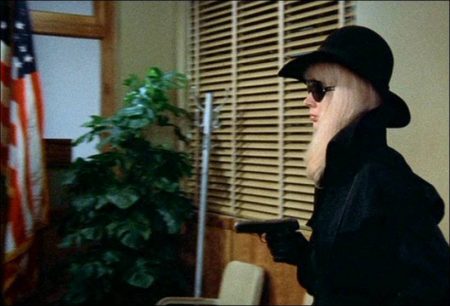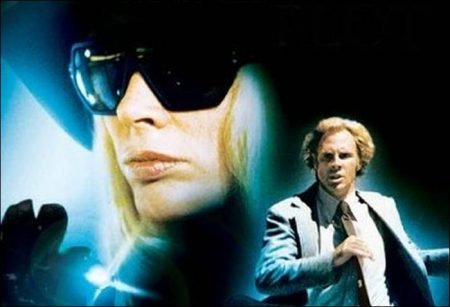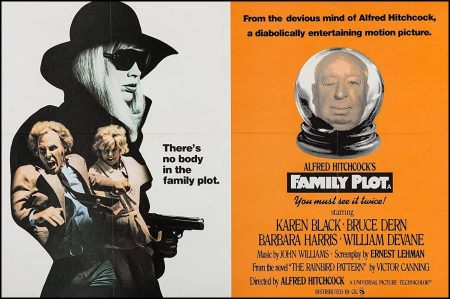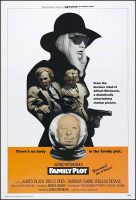
Taglines: There’s no body in the family plot.
Family Plot movie storyline. The trickster Madam Blanche Tyler lures the elder millionaire Julia Rainbird who believes she is a spiritualist. After a séance, she discovers that Julia is tormented by her past, when she forced her sister and single mother Harriet to deliver her baby for adoption to avoid a family scandal. Julia promises the small fortune of ten thousand-dollars to Blanche if she finds her nephew and heir of her fortune using her phony powers.
Blanche asks her boyfriend George Lumley, who is an unemployed actor working as cab driver, to investigate the whereabouts of Julia’s nephew. Meanwhile, the greedy jeweler and collector Arthur Adamson kidnaps wealthy people with his girlfriend Fran to increase his collection of diamonds with the ransom. When George concludes that Arthur Adamson might be the heir of Julia Rainbird, the reckless Blanche gets in trouble with the kidnappers.
Family Plot is a 1976 American Technicolor comedy thriller that was the final film directed by Alfred Hitchcock. It was based on Victor Canning’s 1972 novel The Rainbird Pattern, which Ernest Lehman adapted for the screen. The film stars Karen Black, Bruce Dern, Barbara Harris and William Devane; it was screened at the 1976 Cannes Film Festival, but was not entered into the main competition.
The story involves two couples: one a “fake” psychic and her cab-driving boyfriend, the other a pair of professional thieves and kidnappers. Their lives come into conflict because of a search for a missing heir. The film’s title is a pun: “family plot” can refer to an area in a cemetery that has been bought by one family for the burial of its various relatives; in this case it also means a dramatic plot line involving various family members.
About the Production
The film was adapted for the screen by Ernest Lehman, based on Victor Canning’s 1972 novel The Rainbird Pattern. Lehman wanted the film to be sweeping, dark and dramatic, but Hitchcock kept pushing him toward lightness and comedy. Lehman’s screenplay earned him a 1977 Edgar Award from the Mystery Writers of America.
The novel on which the film is based had earlier been rejected by Lehman, to whom it had been submitted as a potential project for him to either produce or direct, or both. Hitchcock’s other collaboration with the screenwriter, North by Northwest (1959), was followed by several aborted projects. Lehman had incurred the director’s anger by declining an offer to write the screenplay for No Bail for the Judge, a thriller set in London intended to star Audrey Hepburn, Laurence Harvey and actor John Williams. Although Hitchcock eventually had a fine screenplay, and pre-production (location scouting and costumes) was at an advanced stage, the film was never made; Hepburn became pregnant and Hitchcock turned to another project, Psycho (1960), instead.
Hitchcock, who often liked to specify the locales of his films by using on-screen titles or by using recognizable landmarks, deliberately left the story’s location unspecific, using sites in both San Francisco and Los Angeles. The chase scene in the movie, which writer Donald Spoto called a spoof on car chases prevalent in films at the time, was filmed on the extensive Universal backlot. The restaurant used in the film was also built on the backlot and was shown on studio tours in 1975.
Following Family Plot, Hitchcock worked on the script for a projected spy thriller, The Short Night. His declining health prevented the filming of the screenplay, which was published in a book during Hitchcock’s last years. Universal chose not to film the script with another director, although it did authorize sequels to Hitchcock’s Psycho.
Hitchcock considered such actors as Burt Reynolds and Roy Scheider (for Adamson), Al Pacino (for George), Faye Dunaway (for Fran), and Beverly Sills and Goldie Hawn (for Blanche) for the film. Cybill Shepherd wrote in her memoir that she had hoped to play the part of Fran, which eventually went to Karen Black. High salary demands were partly responsible for his turning to other actors.
Although Liza Minnelli was among the stars recommended to Hitchcock, he was especially delighted to work with Barbara Harris as the medium. He had previously tried to hire her for other film projects. Hitchcock had earlier worked with Bruce Dern on episodes of Alfred Hitchcock Presents and on Marnie (1964), in which he had a brief role in a flashback playing a doomed sailor.
Music and Soundtrack
For the score, Universal’s music executive, Harry Garfield recommended John Williams to Hitchcock, following the Oscar and critical acclaim of his music score for Jaws. The film was the only Hitchcock production to be scored by Williams, who has stated that Hitchcock wanted choir voices for Madame Blanche to make her seem psychic towards the beginning, and that Hitchcock was at the scoring sessions most of the time and would often give him suggestions.
For the scene in which Maloney suddenly disappears from Adamson’s office, Hitchcock suggested that Williams stop the music when the camera cuts to the open window to indicate to the audience that Maloney has left through it. Hitchcock then went on to say, “Mr. Williams, murder can be fun”, when he suggested that he should conduct the music lightly for a darker scene of the film. Williams stated that it was a great privilege, and that he had a wonderful working experience with the director.
The complete soundtrack was not released upon the film’s release date. Few themes from the film were released on John Williams and Alfred Hitchcock compilation albums. For years afterwards, the original soundtrack was not available, spawning many bootleg copies of the complete scoring sessions of the film over the internet. Finally in 2010, Varèse Sarabande officially released a limited edition of the complete Original Motion Picture Soundtrack, 34 years after the film’s initial release.
Family Plot (1976)
Directed by: Alfred Hitchcock
Starring: Bruce Dern, Barbara Harris, William Devane, Karen Black, Katherine Helmond, Cathleen Nesbitt, Edith Atwater, William Prince, Marge Redmond, Nicholas Colasanto, Charles Tyner
Screenplay by: Ernest Lehman
Production Design by: Henry Bumstead
Cinematography by: Leonard J. South
Film Editing by: J. Terry Williams
Costume Design by: Edith Head
Set Decoration by: James W. Payne
Music by: John Williams
MPAA Rating: None.
Distributed by: Universal Pictures
Release Date: April 9, 1976
Views: 234


